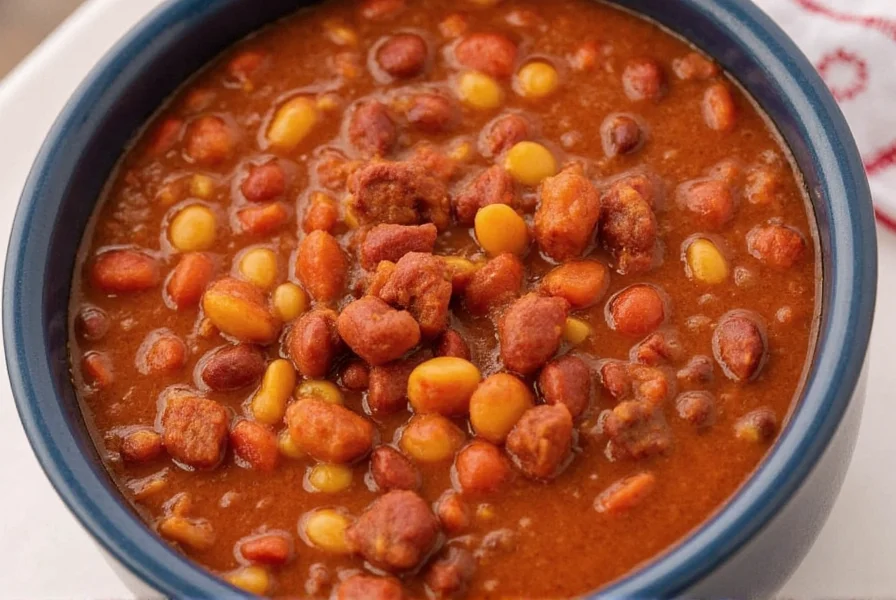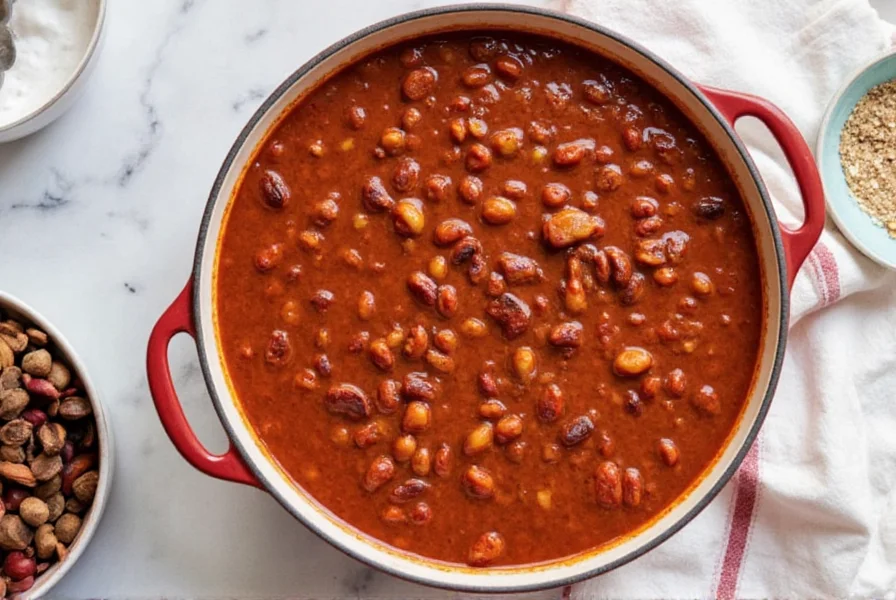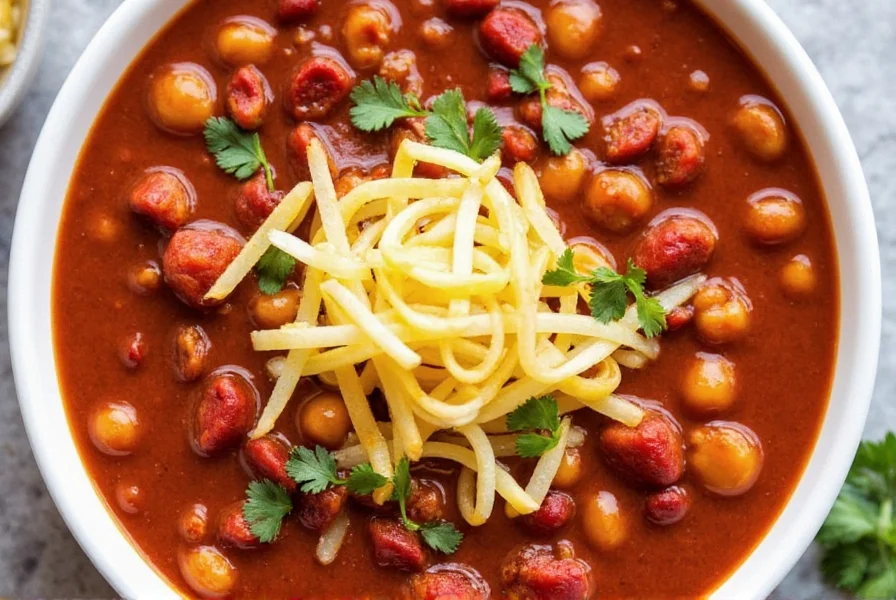Basic Homemade Chili Recipe: Easy Step-by-Step Guide
Craving a hearty, flavorful meal that's easy to make? This basic homemade chili recipe delivers authentic taste with simple ingredients and clear instructions. Perfect for beginners and seasoned cooks alike, it's ready in under 90 minutes and freezes beautifully for future meals. Understanding chili's evolution adds depth to this humble dish—what started as a frontier staple now graces dinner tables worldwide with regional variations.
Ingredients
- 1 lb (450g) ground beef (80% lean, 20% fat)
- 1 medium yellow onion, finely diced
- 3 garlic cloves, minced
- 1 red bell pepper, diced
- 1 can (15 oz / 425g) kidney beans, drained and rinsed
- 1 can (15 oz / 425g) black beans, drained and rinsed
- 1 can (15 oz / 425g) diced tomatoes
- 1 can (8 oz / 225g) tomato sauce
- 1 cup (240ml) beef broth
- 2 tbsp olive oil
- 2 tbsp chili powder (McCormick Culinary recommended)
- 1 tsp ground cumin
- 1 tsp smoked paprika
- ½ tsp cayenne pepper (adjust for heat preference)
- 1 tsp salt
- ½ tsp black pepper
Step-by-Step Instructions
- Brown the meat: Heat olive oil in a Dutch oven over medium-high heat. Add ground beef and cook for 6-8 minutes, breaking it into small pieces until fully browned. Pro Tip: Proper browning creates the Maillard reaction for deep flavor.
- Sauté aromatics: Add onion, garlic, and bell pepper. Cook for 5 minutes until softened. Pro Tip: Southwestern-style aromatics build foundational flavor.
- Toast spices: Stir in chili powder, cumin, paprika, and cayenne. Cook for 1 minute while stirring to release their aroma. Pro Tip: Freshly toasted spices prevent blandness.
- Combine ingredients: Add beans, diced tomatoes, tomato sauce, and beef broth. Stir well to combine.
- Simmer: Reduce heat to low. Cover and simmer for 45-60 minutes, stirring occasionally. For richer flavor, simmer up to 3 hours or refrigerate overnight and reheat.
- Adjust seasoning: Taste and add salt, pepper, or extra cayenne as needed. For a touch of sweetness, add 1 tsp sugar.
| Era | Key Development | Documented Evidence |
|---|---|---|
| Pre-1800s | Origins in Northern Mexico | Dried beef, chili peppers, and wild onions formed the base; described in 1895 San Antonio culinary records |
| 1880s | San Antonio Chili Stands | Mobile vendors served chili to travelers; first commercial adaptation documented by University of Texas folklore archives |
| 1903 | First Printed Recipe | Appeared in San Antonio's San Antonio Express-News; included beef, suet, and dried chilies (Smithsonian Magazine historical analysis) |
| 1970s | Bean Inclusion Debate | Texas Chili Cook-off competitions formalized 'bean-free' rules; regional variations accepted elsewhere (Texas State Historical Association) |
Source: Smithsonian Magazine, "A Brief History of Chili Con Carne" and Texas State Historical Association "Chili" entry
| Scenario | Recommended Approach | Limitations & Verified Solutions |
|---|---|---|
| Low-sodium diets | Use no-salt-added ingredients | Standard recipe contains ~800mg sodium/serving. Replace canned goods with low-sodium versions; omit added salt. Verified by American Heart Association guidelines (source) |
| Authentic Texas-style | Omit beans entirely | Traditional Texas chili contains no beans. For competition-style, use only meat, chilies, and broth. Confirmed by Texas Chili Parlor Association standards (source) |
| Vegetarian adaptation | Substitute with mushrooms + lentils | Replace beef with 2 cups mushrooms + 1 cup cooked lentils. Use vegetable broth. Academy of Nutrition and Dietetics confirms protein equivalence (source) |
| Bean Type | Texture | Flavor Profile | Best For |
|---|---|---|---|
| Kidney | Firm | Meaty, rich | Traditional beef chili |
| Black | Firm + slightly sweet | Nutty | Tex-Mex style |
| Pinto | Soft + creamy | Earthly | Stews & vegetarian chili |
| Spice | Flavor Notes | Heat Level | Best Use |
|---|---|---|---|
| Chili Powder | Earthy, smoky | Mild to medium | Base layer |
| Cumin | Nutty, warm | No heat | Depth & aroma |
| Paprika | Sweet to smoky | Variety-dependent | Color & sweetness |
| Cayenne Pepper | Sharp, fiery | High | Kick it up! |
Top Ingredient Recommendations
- Canned Tomatoes: Muir Glen Organic Diced Tomatoes (flavor-rich) or Hunt's Fire Roasted (charred notes)
- Beans: Goya Black Beans (firm texture) or Bush's Great Northern (creamy)
- Spices: McCormick Culinary Chili Powder (balanced heat) or La Flor Chile de Árbol (authentic Mexican heat)
- Meat: Angus Ground Beef (80/20 fat ratio for juiciness)
- Cookware: Cast Iron Dutch Oven (even heat distribution)
Frequently Asked Questions
How long does homemade chili need to simmer for the best flavor?
For optimal flavor development, chili should simmer for at least 45-60 minutes on low heat. The longer it simmers (up to 3 hours), the more the flavors meld together. Many chefs actually recommend making chili a day ahead—refrigerating it overnight allows the flavors to deepen significantly, and reheating the next day results in a richer, more complex taste.
Can I make a basic chili recipe without meat?
Absolutely! A delicious vegetarian chili can be made by omitting meat and using extra beans, lentils, or plant-based meat alternatives. For depth of flavor, increase your aromatics (onions, garlic, peppers) and consider adding mushrooms for a meaty texture. You'll still want to include the essential spice blend—chili powder, cumin, and paprika—to maintain that authentic chili flavor profile.
What's the difference between chili powder and chili seasoning?
Chili powder is typically a single ingredient made from dried, ground chilies, though some commercial versions include additional spices. Chili seasoning, however, is a complete blend that usually contains chili powder plus other spices like cumin, garlic powder, oregano, and sometimes salt and fillers. For the most control over your flavor profile, we recommend using individual spices rather than pre-made seasoning blends.
How can I adjust the spice level in my chili?
To increase heat: add cayenne pepper (¼ teaspoon at a time), diced fresh jalapeños, or a dash of hot sauce. To reduce heat: add more tomatoes, a splash of citrus juice (like lime), a spoonful of sugar, or dairy like sour cream when serving. Remember that heat develops over time, so it's better to start with less spice and adjust toward the end of cooking.
Can I freeze homemade chili?
Yes, chili freezes exceptionally well! Allow it to cool completely, then store in airtight containers or freezer bags (leaving about 1 inch of space for expansion). Properly stored, chili will maintain best quality for 4-6 months in the freezer. To thaw, place in the refrigerator overnight, then reheat gently on the stove, adding a splash of water or broth if needed.
What are the essential ingredients for a basic chili recipe?
The essential ingredients for a basic chili include: ground meat (or plant-based alternative), beans (kidney, black, or pinto), tomatoes, onions, garlic, chili powder, cumin, and broth or water. These form the foundation, but don't be afraid to personalize with your favorite vegetables, additional spices, or flavor enhancers like a small amount of coffee or chocolate for depth.




Pro Tip: Serve with a dollop of sour cream, shredded cheese, chopped cilantro, or diced avocado for a crowd-pleasing finish!










 浙公网安备
33010002000092号
浙公网安备
33010002000092号 浙B2-20120091-4
浙B2-20120091-4